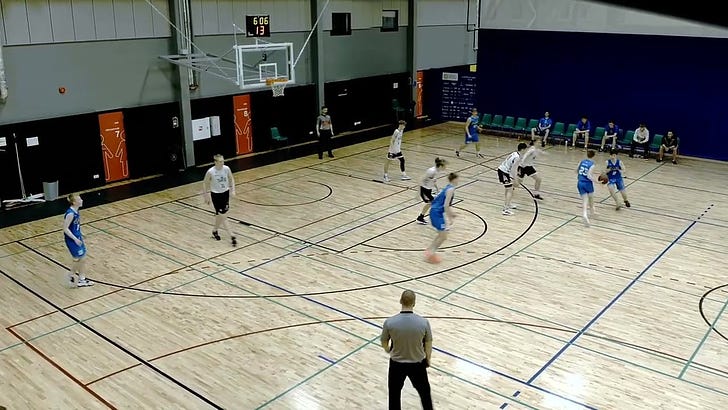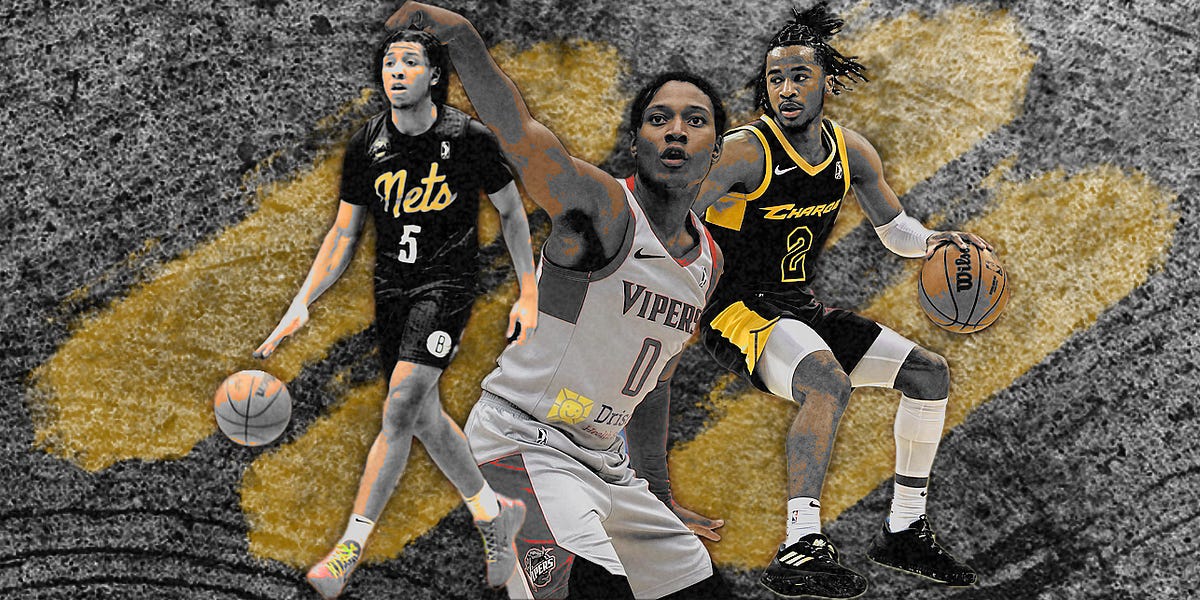- The NBA Librarian Weekly
- Posts
- Are Refs Behind the NBA's Scoring Dip? The Death of NBA Small Guards, NAW's All-D Case, Revolutionizing NBA Defense, Nuggets' Clutch Dominance, and Beyond
Are Refs Behind the NBA's Scoring Dip? The Death of NBA Small Guards, NAW's All-D Case, Revolutionizing NBA Defense, Nuggets' Clutch Dominance, and Beyond
Curating and summarizing the best NBA content of the week

Welcome to the NBA Librarian Weekly, where we curate and summarize the best NBA content of the week.
In Today's Edition:
Additionally, consider subscribing to the Basketball Intelligence newsletter, an excellent source of inspiration for the content I choose to include in mine:
NBA Scoring is DOWN

Look at how many low scoring games there were on Friday!
|
|
NBA scoring has recently taken a dip, a change made more noticeable by last Friday's games where five teams didn't break the 100-point mark. The Magic vs. Knicks game ended at 74-98, marking the lowest-scoring NBA game in six seasons! This shift is quite the departure from the high-scoring discussions dominating the pre-New Year NBA scene.
Post-All-Star break, this downtrend in scoring has become more evident. Analysts like Nate Duncan, Tom Haberstroh, and Seth Partnow delve deeper into this trend, albeit their insights are behind a paywall. However, Sravan offers a visual breakdown, pinpointing a significant drop in free throw attempts as a key factor behind the NBA's reduced scoring.
Taking a closer look, Sravan also explores the individual impact, especially on guards, with Damian Lillard seeing a notable decrease of three free throw attempts per game after January 31st.
This trend might be giving us an early preview of the tighter officiating typically seen in playoff games, suggesting a possible strategic shift in the league's approach to the offensive explosions we saw earlier in the year.
Defending in the Modern Game
In the Hard2Guard Player Development Newsletter, there's some interesting observations on how basketball's offensive strategies have sprinted ahead, leaving traditional defensive tactics panting in the dust. Offense has shifted gears towards quicker plays, less predictability, and a heavy reliance on three-pointers, nudging defenses to rethink old methods. Yet, despite some updates like the adoption of sprint-and-stop closeouts, the essence of defensive training seems stuck in yesteryear, not fully addressing today's fast-paced offensive onslaught.
Brian McCormick then zooms in on a real-game scenario, showcasing how outdated help-and-recover defenses falter against the sleek maneuvers of current offenses. He critiques this conventional approach for its reactive stance, setting players up for tricky, often impossible, tasks. In a refreshing twist, Brian suggests innovative defensive maneuvers like the "Spanish nexting defense" and the "X-closeout," advocating for a proactive rather than reactive defensive strategy.
The piece also introduces "NADA: The Antifragile Defense," a new-age concept aimed at crafting defenses that are adaptable and robust, capable of withstanding the evolved offensive play of modern basketball. The call to action? A revamp of defensive drills and strategies to align with the rapid pace and space of today's game, shedding the obsolete for the innovative.
Examining value of small guards out of the draft
Maxwell Baumbach explores the diminishing role of small guards in the NBA, highlighting the league's preference for positional size and versatility. This trend makes it tougher for smaller players to secure significant roles, both offensively against larger defenders and defensively, where they're often targeted due to their size disadvantage. Baumbach points out that as offenses become more centered around the best player, regardless of position, the traditional small guard's role as the primary orchestrator is less valued, especially if they can't space the floor or defend effectively.
Baumbach analyzed players from the last five drafts, categorizing them as "hits," "whiffs," and "in-betweens" based on their NBA contributions. This analysis aimed to understand the success rate of small guards in the NBA and how it compares to players of other sizes.
His findings show a lower "hit rate" among smaller guards, with success largely dependent on exceptional skills or athletic abilities to compensate for their size. This shift prompts a reconsideration of draft strategies, suggesting teams may need to recalibrate their evaluation criteria to align with the league's evolving dynamics, where size and versatility increasingly dictate a player's potential to contribute and thrive.
Nickeil Alexander’s Case for All-Defense
Will Tzavaras sheds light on Nickeil Alexander-Walker's impact on the Timberwolves, highlighting his defensive agility and prowess that's come to the be extremely critical in the NBA's point-of-attack defender role.
Through engaging video analysis, Tzavaras highlights Alexander-Walker's exceptional lateral quickness and adeptness at navigating screens, qualities that bolster Minnesota's defensive scheme. His long wingspan, coupled with elite hand skills, not only disrupts opponents but also situates him impressively in the 97th percentile for defensive EPM.
Tzavaras further delves into Alexander-Walker's strategic utility against formidable playoff adversaries, illustrating his adaptability and vital role in the Timberwolves' defensive lineup. He even highlights the offensive improvement where he’s become a legitimate floor spacer for the Timberwolves when he’s on the floor — him and Conley make a real nice set of complimenting PG’s to Ant’s attacking style of play.
Nuggets are BETTER in close late games
The Denver Nuggets have distinguished themselves as the NBA's top clutch team over the last decade, particularly thriving in high-pressure playoff-style basketball against elite teams. Their success in crunch time is largely attributed to Nikola Jokić's exceptional play and his synergy with Jamal Murray in the two-man game, complemented by Aaron Gordon's presence as a reliable option near the rim, all of which is supported by excellent shooting and cutting from the team. This multifaceted offensive strategy makes the Nuggets a formidable opponent, especially in tight games.
Defensively, the Nuggets showcase a collective intelligence and physicality that's particularly effective against top-tier competition, with Jokić playing a central role despite perceptions of him as a defensive liability. Their ability to rotate efficiently, recover quickly, and adapt creatively to different offensive threats—coupled with their size and the ability to switch effectively—minimizes the opponents' scoring opportunities in clutch situations. This balanced approach on both ends of the floor has not only cemented the Nuggets' reputation as a clutch team but also positioned them as a tough team to beat in critical moments of high-stakes games.
Pelicans Increased 3 PT shooting
One of my concerns with the Pelicans earlier in the season was their low 3PA volume despite being such a good perimeter shooting team, but they've boosted their 3PT frequency to a much more comfortable level over the last couple months.
— AlexHoops (@AlexHoops_)
5:50 PM • Mar 11, 2024
I wrote an article here about the playing styles of Western Conference teams. One takeaway was that the Pelicans, while proficient in most sets, weren't "elite" or lacking a consistent go-to strategy in any particular category.
AlexHoops effectively illustrates how the Pelicans have tried to combat this through the course of the season, not only by increasing their frequency of three-point shots but also by significantly reducing their attempts from mid-range — this could also be coincided with Zion’s evolving role as a play-maker in the Pelicans offensive sets.
Best Team in the NBA “When Healthy”
🏀💡NBA Offensive and Defensive Rating in games where your 3 best players play, aka "Healthy Net Rating", aka "The Lakers ain't it".
— craftedNBA (@craftedNBA)
8:48 PM • Mar 8, 2024
Great graphic showing the net ratings of all teams when their three best players are healthy. My biggest takeaways:
Philadelphia with Embiid is elite offensively and defensively.
Memphis is really good defensively when healthy — but they desperately need to a.) get healthy and b.) improve their offensive efficiency.



